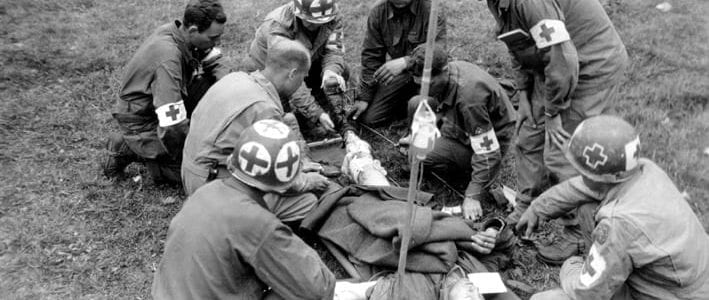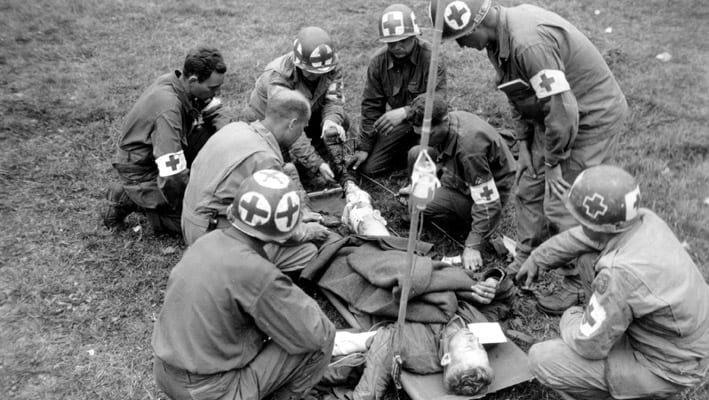The 1COLD team will be observing the 2-minute silence to commemorate those who gave their lives to ensure the freedom of future generations. We will remember them.
Medicines are used to keep the armed forces in the best health possible in times of war, when the military personnel are facing injury and death every day in the conflict zones. During World War II, the potential for injury was greater than ever before, because of the types of weapons used.
While aircraft, submarines, machine guns and tanks were in their infancy during the Great War, they were widespread by 1939 and had been honed to perfection. In addition, land and sea-based artillery, small arms, torpedoes and armour-piercing bombs wreaked a terrible toll on human life.

© Public Domain
Treating diseases
As well as nursing troops who had been injured in action, keeping the forces fit and healthy involved recognising that diseases could threaten their well-being as much as the fighting. During the early years of the Pacific campaign (which began in December 1941), malaria caused many casualties.
It was essential to get malaria and other tropical diseases under control before the Pacific war could be won. Physicians and medics would dispense quinine and atabrine to combat malaria. The Second World War brought about the mass production of antibiotics, such as penicillin and sulfanilamide, for the first time.
Penicillin
Penicillin had been discovered by Alexander Fleming, a Scottish bacteriologist, in 1928, when he noticed that mould forming in his Petri dishes had eliminated the bacteria in them. Initially, his discovery wasn’t greeted with much enthusiasm by the scientific world, but he persisted with his research, came up with the name “penicillin” and eventually won the Nobel Prize for his invention.
Pharmaceutical company Pfizer began mass-producing penicillin and it was distributed to medics during World War II. It gained the respect of the medical profession and was also given to hospitals and doctors across Britain.
Sulfanilamide
Sulfanilamide was created in 1932 by German biochemist Gerhard Johannes Paul Domagk. He discovered it could cure people suffering from deadly bacteria, such as streptococcus. After developing the medicine in his lab, he tested it on his first human subject, his seriously ill daughter.
The drug saved her life and prevented the amputation of her arm. It became known as the “sulfa drug” and was distributed among the soldiers, who were given their own supply in their first aid kits.
By the time the war ended in 1945, the antibiotics were being routinely used by doctors to treat serious infections, such as meningitis and streptococcus.
Military medics
The top priority during the war was treating battle casualties in all theatres of war. Both the army and navy faced a massive challenge, as the intense warfare was fought far away from the regular hospitals, putting a huge strain on the medics closest to the front.
The most demanding task for a military medic was tending to army infantry or Marine Corps units. Medics would suffer the hazards of combat themselves, as the majority of them were unarmed – as they must reserve their strength for carrying the medical supplies.
The medics were the first link in the evacuation process for wounded service personnel. From the moment a soldier was injured on the battlefield, the medic would brave enemy fire to provide aid. He must tend to a wound by applying a dressing and administer morphine to stop the pain.
He would also have a glass bottle filled with a fluid that could bring a wounded soldier back to life. In the early years of the war, it was plasma. Then, medical research produced the blood substitute, serum albumin. Finally, blood became available for transfusions in medical facilities near the battlefield in 1945.
Evacuating casualties
Medics would provide on-the-spot treatment before the casualty was evacuated to a divisional hospital, where he could have surgery if required.
In the Pacific zone, sailors, marines and soldiers were taken to navy and army hospital ships, that were used to provide medical care and as ambulances to take the wounded to local base hospitals, or back to the US for further care if needed. Trained nurses and medics were on hand to provide care on the journey. When wounded troops were airlifted home, trained medics were on the planes too.
Medical innovations
Some of the medical innovations that began on the battlefield moved to mainstream medicine in peacetime. One such practice dated from the 16th century, during conflict in Italy, when a French surgeon called Ambroise Pare was caring for soldiers at the Siege of Turin. He was horrified by the way open wounds were cauterised using boiling oil and introduced ligatures instead.
He persuaded civilian doctors to use ligatures or tourniquets, a method still used today, not only on battlefields, but also at the site of accidents and natural disasters and in emergency rooms.
The surgical removal of dying tissue (called debridement) reduced infections in wounded soldiers. During WWII, skilled surgeons learned how to preserve limbs that may have been amputated in previous wars.
Ambulances
The practice of using official ambulances to transport patients and vital medicines around the battlefield began in the American Civil War in the 1860s. Army doctor Major Jonathan Letterman introduced an efficient horse-drawn ambulance system that was the first model for today’s emergency transport.
Before every battle, he would set up a convoy of 50 ambulances, carrying medical supplies such as bandages and medicines including morphine. Each vehicle had a stretcher on board, a designated driver and two men to carry the patient. He later added a locked box, under the driver’s seat, to carry the medicines, preventing bandits from stealing them. Spring suspension was added to the vehicles for a smoother ride over the rough terrain.
His ideas led to faster treatment for war wounds and a better recovery rate.
Quicker treatment
The concept that an injured patient should ideally be treated within one hour of a multiple trauma came about as a result of data gathered by the French during the Great War. Prior to this, it had been common for wounded soldiers to lie on the battlefield for up to two days. By the Second World War, the idea of the “golden hour” had come into effect and planes were used to move the severely injured to hospital, giving them the best chance of recovery.
By the time the Second World War ended in 1945, it had impacted on treatments and medicines in both the military and civilian world. Combat theatres had provided a testing ground for evacuation procedures, blood substitutes, new surgical techniques, the latest drugs and preventive medicine.




